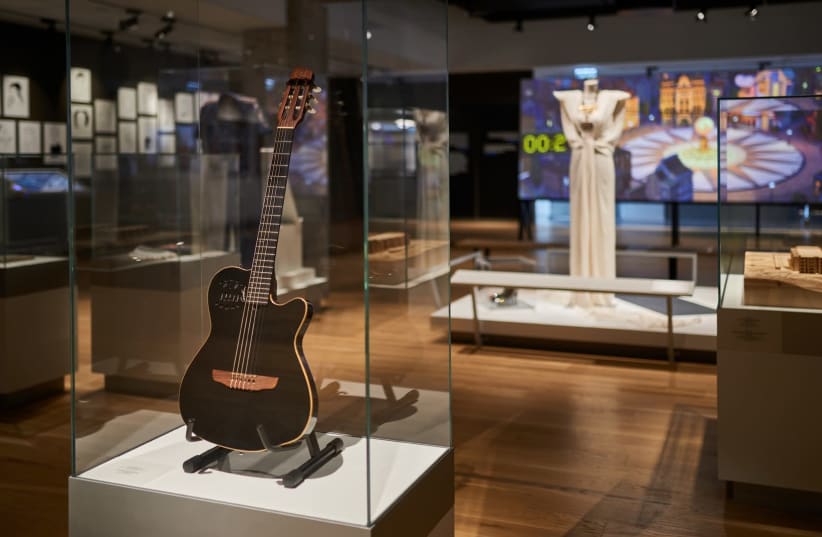Forget about dusty dioramas. ANU – Museum of the Jewish People in Tel Aviv, has opened to the public with interactive displays, films and objects spanning the gamut of Jewish culture, history and civilization.
The huge museum – 6,700 square meters – covers three floors. Visitors are meant to enter on the third floor called “The Mosaic,” which deals with modern Jewish identity and culture.
There are some unique objects here, including Nobel Prize-winning writer Isaac Bashevis Singer’s personal typewriter, Leonard Cohen’s guitar that he played during his last concert in Israel, and my personal favorite: the collar worn by the late Supreme Court justice Ruth Bader Ginsburg.
There are also some great interactive music displays with headphones. A virtual reality station with lullabies in different languages is on hold now because of COVID-19, but hopes to open soon. You can already listen to hundreds of songs with headphones, from classical to rock to pop. There are also recordings of Jewish singers in Arab countries as well as their biographies.
I got a little lost in a cooking display where you swipe your fingers across the screen to “cook,” and my stuffed mangold leaves turned out beautifully.
“It’s the largest and most comprehensive Jewish museum in the world,” Dan Tadmor, the CEO of ANU, The Museum of the Jewish People told The Jerusalem Post. “It’s over 72,000 sq.ft., but more importantly it’s comprehensive. It’s the only museum in the world that tells the story in its entirety. It’s the story of Jews throughout the world, historically, from Abraham up until this day, and also in terms of the breadth of Jewish identity in terms of cultural beliefs. The scope of the museum is like none other.”
After leaving the modern era, the visitor goes down one floor to “The Journey – The Jewish Story Through Time.” Here there is the full narrative of the Jewish people around the world. Tadmor pointed out a small medallion with the face of a woman that is labeled “Fatima, daughter of Mohammed.”
“You might ask what that is doing in a Jewish museum,” Tadmor said. “Between 1839 and the 1920s they were forced [to convert] to Islam but kept their Judaism in hiding. When the women were smuggling prayer books to the men in hiding, they used to wear these medallions so if they were stopped on the street and asked ‘What are you doing?’ they would say, ‘I’m a good Muslim and here’s a picture of Fatima.’”
The bottom floor is titled “The Foundations – A Common Core, A Universal Message” and has exhibits on Jewish practices and beliefs, including works by modern artists that were commissioned by the museum, along with 50 new short films.
The $100 million museum, which replaces Beit Hatfutsot – The Museum of the Jewish People (formerly the Nahum Goldmann Museum of the Jewish Diaspora) on the campus of Tel Aviv University, was designed and built over the past 10 years. It was funded by both the State of Israel, the Nadav Foundation and private philanthropy. Museum board chairwoman Irina Nevzlin, who is also the president of the Nadav Foundation, spoke at the opening about growing up in Soviet Russia.
“I didn’t find out I was Jewish until I was seven years old,” she said. “Somebody on the street called me a ‘dirty Jew,’ and then my grandmother told me we were Jewish but we shouldn’t talk about it,” she said.
When she was 13, she came to Israel for the first time, “and I felt I was home,” she said. That sense of identity led her to transfer to a Jewish school, and later to her eventual aliyah and involvement in the museum.
Chief curator Dr. Orit Shaham-Gover said the museum takes a completely different attitude to the Jewish story than previous museums have.
“We decided to give up the position of the victim,” she told the Post. “When we look back at the Jewish story we see a lot of ingenuity, creativity, cultural dialogue and prosperity. We also see atrocities, but we give them a different balance. Instead of looking back and saying ‘gevalt,’ we look back and say ‘hallelujah.’”
ANU – Museum of the Jewish People is open daily, including Saturday, and until 10 p.m. on Thursdays. There is an audio guide available and tours in several languages.
Tickets cost NIS 52 for adults and children over five, NIS 26 for seniors, and entry is free for children under five and soldiers in uniform.
For more information visit anumuseum.org.il
